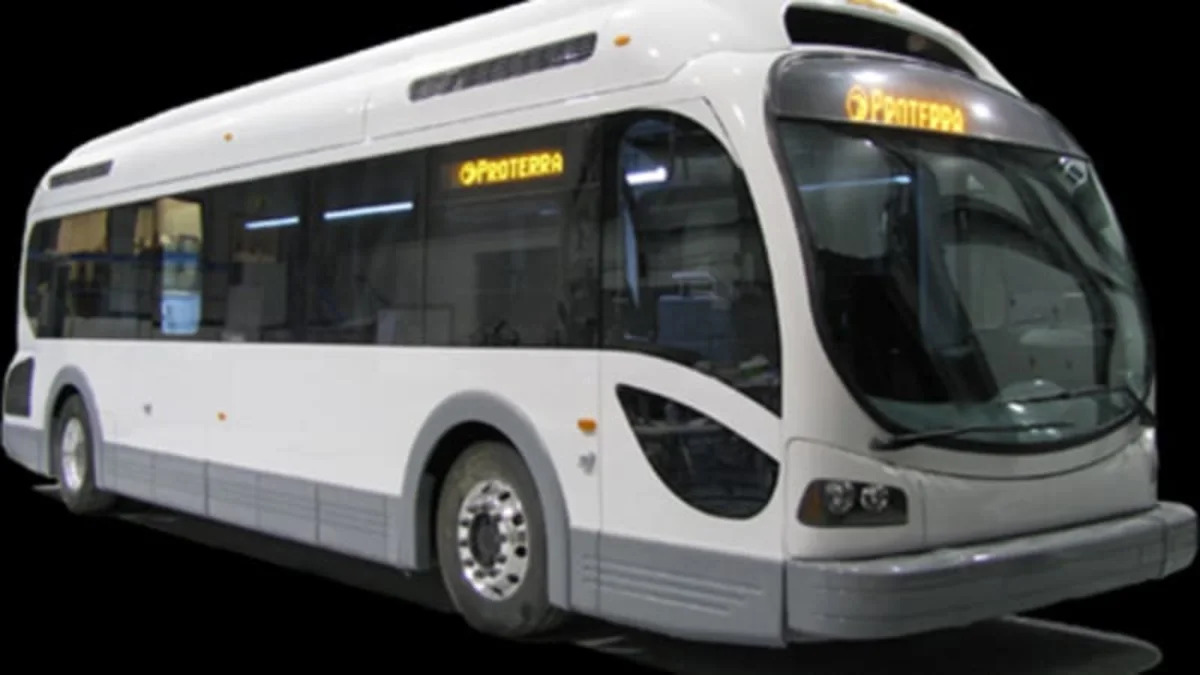Burbank Bus has announced that they will be trying out the world's very first plug-in hydrogen fuel cell hybrid transit bus (say that fast 5 times), the Proterra HFC35, beginning this Spring. Now, we've had all-electric buses, turbine-powered hybrid buses and even a plug-in school buses gracing the pages of AutoblogGreen before, but we must admit that this is probably the first bus with this exact configuration.
Such a unique drivetrain should receive an equally singular package to wrap it in and in that department the Proterra doesn't disappoint. The compact 35 footer forgoes the traditional exterior sheet metal in favor of a molded composite shell that allows it to sport a modern look and keep its weight to a minimum. Using battery cells from Altairnano, the HFC35 is capable of completely recharging in six minutes with Proterra's quick charge station to limit its hydrogen usage, but it can travel up to 250 miles before needing more hydrogen or electricity. Burbank will give it a grand unveiling this Spring before putting it to work on various routes. Hit the jump for all the press release details.
Such a unique drivetrain should receive an equally singular package to wrap it in and in that department the Proterra doesn't disappoint. The compact 35 footer forgoes the traditional exterior sheet metal in favor of a molded composite shell that allows it to sport a modern look and keep its weight to a minimum. Using battery cells from Altairnano, the HFC35 is capable of completely recharging in six minutes with Proterra's quick charge station to limit its hydrogen usage, but it can travel up to 250 miles before needing more hydrogen or electricity. Burbank will give it a grand unveiling this Spring before putting it to work on various routes. Hit the jump for all the press release details.
[Source: Burbank Bus Via Green Car congress]
PRESS RELEASE:
CITY OF BURBANK TO PREMIER WORLD'S FIRST PLUG-IN FUEL CELL TRANSIT BUS
Demonstration Project to Launch with Zero Emissions Vehicle in Spring 2009
BURBANK, Calif. (December 16, 2008) – The City of Burbank has been selected as a national test market for a new zero-emissions, ultra-quiet prototype bus that uses a hydrogen fuel cell instead of a diesel or gasoline engine. The breakthrough vehicle will be unveiled in a spring 2009 Downtown Burbank ceremony and then go into immediate service on various routes within the City's BurbankBus network.
Designed and fabricated by Colorado-based Proterra, the revolutionary vehicle can travel 250 miles before needing to be recharged, runs at double the fuel economy of a diesel bus and releases nothing but water from the engine exhaust. In addition to being created and built in this country, it relies on power that is 100% derived from U.S. sources, thereby reducing dependence on foreign energy.
The vehicle features several world-firsts for public transportation:
* It is the first-ever light-weight composite bus that is purpose-built to be a plug-in hybrid, offering the advantage of super fuel efficiency
*It is the first to apply mass-produced smaller output (< 50 kW or < 67 HP) automotive fuel cells as range extension to a plug-in hybrid bus, and as such substantially reduces vehicle and lifetime operating costs
* And it offers the world's first fast-charge battery technology, which is capable of fully recharging the battery in a record 6 minutes. This allows buses to re-power during driver rest breaks.
The technology is very similar to that used in 2010 next-generation plug-in hybrid vehicles, such as the Chevy Volt. On-board computers regulate the electrical needs of the engine by alternating between power fed by Proterra's TerraVolt energy storage system, and power derived from the hydrogen fuel cells developed by Hydrogenics Corporation. These cells are fed by pressure tanks located on the vehicle's roof, and transform hydrogen and oxygen into water vapor and electricity to charge the batteries. The vehicle may also be recharged by plugging into readily available wall outlets, like many of the new hybrid cars.
"The significance of this milestone program is that we are able to harness the latest transportation technology and put it into service for the public good," states Johnathan Frank, Administrative Analyst with the Transportation Department of the City of Burbank. "Zero-emissions will help the environment, which is a critical
issue in Southern California. We're excited to be the first program of its kind in the state."
Introducing this emerging fuel technology is just part of the matrix of new ideas that mark this radical transportation redesign. Other factors that were considered include vehicle weight and maneuverability. To address the weight issue, the bus was reconfigured to 35 feet long, shaving off space of about five feet that is typically devoted to accommodating bulky diesel engines. The hydrogen vehicle's more compact length reduces the total weight load and contributes to fuel efficiency while maintaining equal passenger capacity (37 seated, 30 standing).
The outer shell of the bus was also taken into account. The traditional stamped sheet metal exterior was replaced with a sleek molded composite frame. The result not only reduces the vehicle's overall weight, but allows for an impressive streamline, space-age profile.
"Working with the City of Burbank will give this new technology a wonderful boost," states Joshua Goldman, Director, Business Development for Proterra. "This real-life demonstration within a thriving public transportation system will give us the learning tools to advance this emerging and much-needed alternative technology."
For further information on hydrogen vehicle technology, please visit the National Renewable Energy Laboratory website at www.nrel.gov. To discover how it is being exploited for public use, such was the BurbankBus initiative, please visit www.proterraonline.com and www.hydrogenics.com.
Other agencies involved in this pioneering project include California Air Resource Board (CARB), California Energy Commission and the Federal Transit Administration (FTA).
# # #


Sign in to post
Please sign in to leave a comment.
Continue